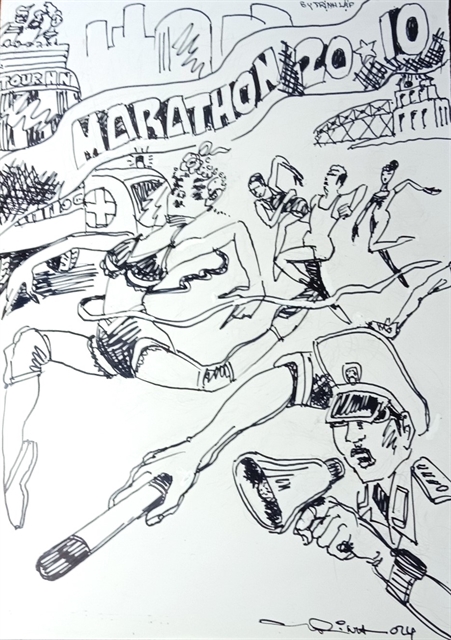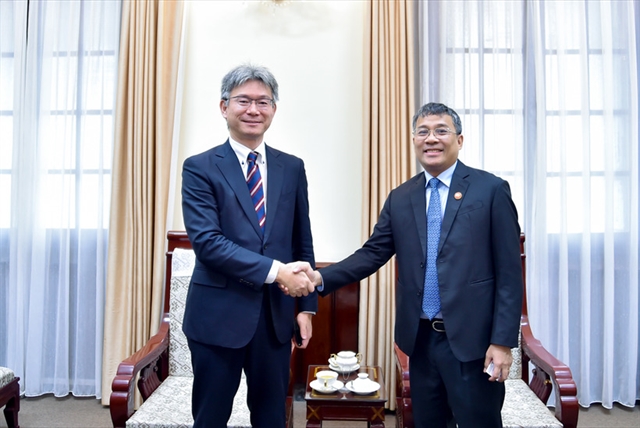 Talk Around Town
Talk Around Town


|
| Illustration by Trịnh Lập |
By Thanh Nga
Marathon running has, over recent years, sparked a fitness revolution across Việt Nam, captivating both dedicated athletes and casual participants.
As the year nears its end, Hà Nội transforms into a vibrant hub for these events, with cool weather offering ideal conditions for runners. Enthusiasm for marathons is undeniable, however, it has also prompted intense discussions on their impact on local residents.
Supporters argue that marathons promote healthy lifestyles and enhance the physical wellbeing of the runners. They highlight the events' ability to foster community spirit and boost local tourism, drawing participants from around the world. The excitement surrounding these races often creates a festive atmosphere, uniting runners and spectators in a shared celebration of fitness and camaraderie.
Yet, this enthusiasm is not shared by all. Critics raise concerns about the practicality of hosting marathons in densely populated cities like Hà Nội. Organised in a limited space and with heavy traffic, these races can disrupt the daily lives of residents, especially those living along the race routes. Many locals report being stuck in traffic jams or delayed on their way to work, leading to frustration and economic repercussions.
Earlier this month, more than 18,000 athletes from 55 countries gathered at Thống Nhất Park for a marathon, with some arriving as early as 2am. Organisers carefully planned traffic flows to ensure safety for runners and the public. However, the sheer number of participants navigating crowded streets in Hoàn Kiếm and Hai Bà Trưng districts still led to significant disruptions, especially at busy intersections.
Volunteers and police worked tirelessly to manage the chaos, often facing frustrated motorists forced to wait.
“Some drivers, tired of waiting, tried to push through the crowds, risking accidents with the runners,” said Nguyễn Hà Nam, a volunteer. “At times, we had to slow down the athletes to let vehicles pass, which understandably frustrated those aiming for personal bests.”
Local residents have their own stories. Vũ Thị Hương, who works at a hospital, expressed her frustration when her usual route was blocked. “I had to leave my motorbike at home and take a longer path on foot just to catch a motorbike taxi,” she said, adding that the detour not only cost her time but also added unnecessary stress to her morning routine.
Similarly, Nguyễn Văn Long, a resident near Thiền Quang Lake, lamented the disturbance to his neighbourhood's peace. “The noise was unbearable at night during the two races last month. My family struggled to sleep with all the commotion,” he said, highlighting the often-overlooked impact of these events on local residents.
Voices in the community are growing louder, with many questioning the balance between promoting fitness and respecting public daily life. “Running is great for health, but we need a way to host these events without inconveniencing everyone else,” wrote Đức Trung in an online forum. “It’s not just about the runners; many of us have jobs and commitments that require us to be mobile.”
Concerns about road closures and delays have led to discussions on accountability. Who is responsible when main routes are blocked, causing delays for those heading to airports or emergencies?
It is reported that HCM City hosts around 50-60 big races annually, while Hà Nội holds about 30-40. With hundreds of marathons held annually across the country, many locals feel the strain of repeated disturbances of public life.
In a recent incident in Cần Thơ, public anger even erupted when thousands of runners filled the streets during peak traffic hours, endangering themselves and motorists. Such incidents underscore the need for better planning and coordination between event organisers and local authorities.
Some residents are calling for a review of regulations for public events to address these concerns. “Organisers should notify local communities well in advance,” proposed Hùng Tiến from Long Biên District. “It’s essential that residents along the race routes are informed about closures and timings to minimise disruption.”
To improve the experience for both runners and local residents, marathon organisers must prioritise communication. By clearly sharing race times and routes, they can help mitigate the impact on the community and foster a more harmonious relationship between runners and locals.
While promoting sports and fitness is a noble cause, it is crucial to organise these events with responsibility and consideration for all community members.
A well-planned marathon can inspire a healthier, more active society without infringing on the daily lives of those who call the city home. Balancing enthusiasm for running with the needs of the community is key to ensuring the marathon movement thrives for years to come. VNS




